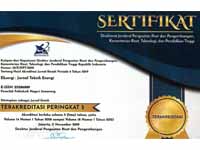Utilization of Welding Electrode Waste To Purify Biogas From Hydrogen Sulfide Impurities
DOI:
https://doi.org/10.32497/eksergi.v19i2.4451Keywords:
adsorption, biogas, desulfurization, hydrogen sulfide (H 2 S), welding electrode.Abstract
Abstract”” The biogas desulphurization process has a crucial role in the widespread use of biogas due to the toxic and corrosive nature of the element hydrogen sulfide on equipment. This study investigated the potential use of waste welding electrodes as a biogas purification medium. Variables in the form of feed biogas flow rates of 1, 2, and 3 liters/minute were studied for their effects. As a result, the most optimum performance was obtained in the test with a feed biogas flow rate of 1 liter/minute, with an average reduction percentage of hydrogen sulfide content in the biogas of 27.12%.
References
N. Apriandi, Suwarti, and W. P. Widyaningsih.
“Produksi biogas dari kotoran sapi menggunakan
digester anaerobik tipe batch skala kecil: pengaruh
hydraulic retention time (HRT) terhadap kualitas
biogas”. Jurnal Sains dan Teknologi, vol. 12 (1). 2023.
N. Apriandi. “Analisa biodigester polyethilene skala
rumah tangga dengan memanfaatkan limbah organik
sebagai sumber penghasil biogas”. Orbith: Majalah
Ilmiah Pengembangan Rekayasa dan Sosial, vol. 17 (1),
pp. 23-29. 2021.
C. Xio, Y. Ma., D. Ji., and L. Zang. “Review of
desulfurization process for biogas purification”. IOP
Conf. Series, pp. 1-7. 2017.
G. M. Araujo. “Remocao biologica de gas sulfidrico
concentrado para tratamento do biogas”. UFSM. 2013.
C. M. Becker, M. Marder, E. Jungas, and O. Konrad.
“Technologies fo biogas desulfurization ”“ An overview
of recent studies”. Renewable and Sustainable Energy
Reviews, vol. 159. 2022. [6] N. Apriandi, W. P. Widyaningsih, Margana, M. D.
Surindra, Supriyo, and N. T. A. Luthfiana. “Biogas
desulfurization using iron gram waste machining
practicum process at the Department of Mechanical
Engineering, Politeknik Negeri Semarang”. Eksergi,
vol. 18 (3), pp. 182-185. 2022.
T. G. T. Nindhia, K. M. T. Negara, I. M. Sucipta, I. W.
Surata, I. K. A. Atmika, and D. N. K. P. Negara,
“Performance of Repetitive Type of Biogas
Desulfurizer Made from Steel Chips Waste,” in
Proceedings of the 2nd International Converence on
Sustainable Technology Development, 2012, pp. 63”“69.
Q. J. Dai, L. I. Yi, and X. J. Fang. “Discussion on
corelation between sulfur in sludge an hydrogen sulfide
in biogas”. China Water & Waste Water. 2008.
P. I. Cano, J. Colon, M. Ramirez, J. Lafuente, D.
Gabriel, and D. Cantero. “Life cycle assessment of
different physical-chemical and biologycal technologies
for biogas desulfurization in sewage treatment plants”.
J. Clean Prod., vol. 181, pp. 663-674. 2018.
F. Ardolino, G. F. Cardamone, F. Partillo, and U. Arena.
“Biogas to biomethane upgrading: a comparative
review and assessment in a life cycle perspective”.
Renewable Sustainable Energy Review. vol. 139 (14).
A Choudhury and S. Lansing. “Adsorption of hydrogen
sulfide in biogas using a novel iron-impregnated biochar
scrubbing system”. J. Environ Chem Eng. vol. 9, pp. 18.
L. R. Lopez, A. D. Dorado, M. Mora, X. Gamisans, J.
Lafuente, and D. Gabriel. “Modelling an anaerobic
biotricling filter for biogas desulfurization through a
multi-step oxidation mechanism”. Chem Eng J. vol.
, pp. 447-457. 2016.
F. Almenglo, T. Bezerra, J. Lafuente, D. Gabriel, M.
Ramirez, and D. Cantero. “Effect of gas liquid flow
pattern and microbial diversity analysis of a pilot scale
biotricling filter for anoxic biogas desulfurization”.
Chemosphere. vol. 157, pp. 215-223. 2016.
X. Jiang, J. Wu, Z. Jin, S. Yang, and L. Shen.
“Enhancing the removal of H2S from biogas through
refluxing of outlet gas in biological bubble-column”.
Bioresour Technology. vol. 299 (7). 2020.
E. Tilahun, E. Sahinkaya, and B. Calli. “A hybrid
membrane gas absorption and bio-oxidation process for
the removal of hydrogen sulfide from biogas”. Int
Biodeterior Biodegrad. vol.127, pp. 69-76. 2018.
J. J. Su, and Y. Y. Hong. “Removal of hydrogen sulfide
using a photocatalytic livestock biogas desulfurizer”. Renew Energy. vol. 149, pp. 181-188. 2019.
A. Widyastuti, B. Sitorus, and A. Jayuska, “Karbon Aktif Dari Limbah Cangkang Sawit Sebagai Adsorben Gas Dalam Biogas Hasil Fermentasi Anaerobik Sampah Organik,” JKK, vol. 2, no. 1, pp. 30”“33, 2013.
T. G. T. Nindhia, I. W. Surata, I. D. G. P. Swastika, and
P. Widiana, “Processing zinc from the waste of used zinccarbon
battery with natrium chloride (NaCl) for biogas desulfurizer,” in Key Engineering Materials, vol. 705,
pp. 368”“373. 2016.
T. G. T. Nindhia, I. W. Surata, I. K. A. Atmika, D. N.
K. P. Negara, and I. P. G. Artana, “Processing Carbon Rod from Waste of Zing-Carbon Battery for Biogas
Desulfurizer,” Journal of Clean Energy Technologies,
vol. 3, no. 2, pp. 119”“122, 2015.
T. G. T. Nindhia, I. W. Surata, and R. Antara,
“Pemanfaatan Limbah Cangkang Tiram Untuk
Memurnikan Biogas Dari Pengotor Karbondioksida,”
Buletin Udayana Mengabdi, vol. 16, no. 1, pp. 128”“132,
S. M. Rambe and E. H. Sipahutar, “Rekayasa Adsorben
Dari Limbah Serbuk Besi Untuk Penyerapan H2S
Dalam Biogas,” Jurnal Teknik dan Teknologi, vol. 11,
no. 22, pp. 13”“19, 2016.
M. R. Pelaez-Samaniego, J. F. Perez, M. Ayiania, and
T. Garcia-Perez, “Chars from wood gasification for
removing H2S from biogas,” Biomass and Bioenergy,
vol. 142, Nov. 2020. [23] M. F. Obis, P. Germain, O. Troesch, M. Spillemaecker,
and H. Benbelkacem. “The effect of the origin of MSWI
bottom ash on the H2S elimination from landfill
biogas”. Waste Manag. vol. 70, pp. 158-169. 2017.
M. W. Ilham. “Analisis kombinasi elektroda pada
pengelasan material baja dengan stainless steel ditinjau
dari sifat mekanik”. Skripsi: Institut Teknologi Sepuluh
November. 2017.
N. Apriandi, I. G. B. W. Kusuma, and I. M. Widiyarta.
“Pemurnian biogas terhadap gas pengotor
karbondioksida (CO2) dengan teknik absorbsi kolom
manometer (manometry column)”. Logic: Jurnal
Rancang Bangun dan Teknologi. vol. 13 (1), pp. 55.
Downloads
Additional Files
Published
Issue
Section
License
Authors who publish with this journal agree to the following terms:Authors retain copyright and grant the journal right of first publication with the work simultaneously licensed under a Creative Commons Attribution License that allows others to share the work with an acknowledgement of the work's authorship and initial publication in this journal.
Authors are able to enter into separate, additional contractual arrangements for the non-exclusive distribution of the journal's published version of the work (e.g., post it to an institutional repository or publish it in a book), with an acknowledgement of its initial publication in this journal.
Authors are permitted and encouraged to post their work online (e.g., in institutional repositories or on their website) prior to and during the submission process, as it can lead to productive exchanges, as well as earlier and greater citation of published work (See The Effect of Open Access).






